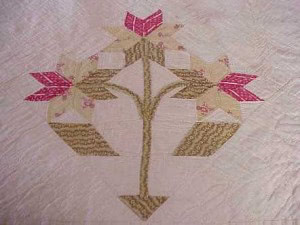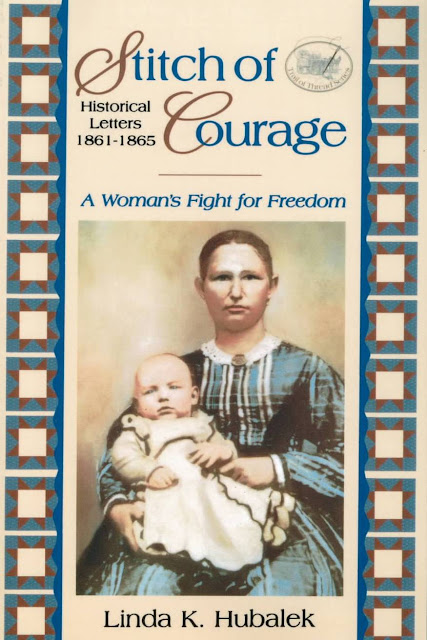(Caroline Clemmons interviewed me for her book review blogspot. She posted an excerpt from my book, Trail of Thread too. Please enjoy both.)
Caroline: Readers love to get to know authors. Share anything that lets readers get to know the real you.
Linda: I grew up on a wheat farm in central Kansas. This farm was featured in my Butter in the Well series, and my parents still live there. I was a shy tomboy who preferred being outdoors, and working with animals, farming or gardening—rather than being inside doing housework and cooking. (And my husband would say I’m still that way.)
I have two older brothers and a younger sister and we were all involved in 4-H, church and community projects growing up. One brother now farms the family land and the other two live out of state. My husband and I have lived in three other states due to job careers, but then moved back to Kansas in the 1990s to be close to family.
Caroline: Who are your favorite authors and favorite genres?
Linda: When I read books, it’s right before bedtime so I want something fun, romantic, and not something that will give me nightmares. Right now I’m into contemporary western romances.
Caroline: How many books do you read a month? What are you reading now?
Linda: Depending on the time of year, I read from two to eight books a month. I seem to have a “Linda” theme at the moment…as I’ve been reading Linda Lael Miller’s and Linda Warren’s books.
Caroline: Can’t go wrong there. When you’re not writing, what’s your favorite way to relax and recharge?
Linda: Reading in a quiet room with a nice stash of chocolates…or out walking….off those chocolates…
Caroline: Can I stay behind with the book and chocolates? 😀 Would you like to share any guilty pleasures that feed your muse?
Linda: Chocolates and chocolate ice cream is my guilty pleasure…for any reason!
Caroline: Me, too. How long have you been writing?
Linda: I started writing books in 1992 when my husband was transferred to California for a two-year engineering project. I was homesick for the Midwest and started writing about the Swedish immigrant woman that homesteaded our family farm.
Caroline: Where do you prefer to write? Do you need quiet, music, solitude? PC or laptop?
Linda: I write in my office with my big computer monitor and curved keyboard attached to my laptop. It’s got to be absolute quiet for me to concentrate so nobody can be in the room with me.
Caroline: Are you a plotter or a panzer?
Linda: Do I plan ahead or charge my way through life or writing? Depends on the day and the situation!
Caroline: I always ask here if you use real events or persons in your stories, but I know that you do.
Linda: All my series have been based on real people, places and the events that went on during their lifetime. It’s a good way to get the research and story started.
Caroline: I was impressed with evidence of your research for TRAIL OF THREAD. Do you research before you begin a new project, or as you go along?
Linda: I start out with lists of ideas first, then research, then outline, then start expanding the chapters—combining everything I’ve absorbed in the process.
Caroline: Tell us about your writing schedule. Do you set goals? Do you write daily?
Linda: My day depends on life…and aging parents’ doctor’s appointments right now. I don’t set goals like I used to as something unforeseen can change and then just makes life stressful. I write something every day and sometimes at night in my dreams too.
Caroline: Yes, family comes first. Do you write full time or do you have a day job. If you have a day job, what is it?
Linda: I’m just getting back to full-time writing. We started raising bison in the 1990s and we ended up opening a Visitor Center on our farm because we had so many people coming in for tours. But both us— and the buffalo herd—were getting tired of tourists and being open seven days a week, so we closed it last year to get our lives back to a more normal pace.
Caroline: I love that you use your ancestors as souces. What do you hope your writing brings to readers?
Linda: I hope my writing gives readers a sense of their ancestors’ lives, and to maybe search out their own ancestors’ stories.
Caroline: What advice would you give to unpublished authors?
Linda: Now you can publish your work by yourself on the internet if you don’t want to look for a publisher, but please be sure to protect your book as best you can with an ISBN, copyright date, etc. You can learn how to do all of this through the internet.
Caroline: Tell us about TRAIL OF THREAD.
Back cover blurb: Taste the dust of the road and feel the wind in your face as you travel with a Kentucky family by wagon trail to the new territory of Kansas in 1854. Find out what it was like for thousands of families who made the cross-country journey into the unknown.
In this first book of the TRAIL OF THREAD series, in the form of letters, Deborah Pieratt describes the scenery, the everyday events on the trail, and the task of taking care of her family. Stories of humor and despair, along with her ongoing remarks about camping, cooking and quilting make you feel as if you pulled up stakes and are traveling with the Pieratts too.
Excerpt from Trail of Thread: January 24, 1854 . . .
“I don’t usually pay attention when the men talk about politics, but I automatically listened while I laid the dishes of food in front of them. They were discussing the new government bill that proposes to open up prairie Indian land, west of Missouri, to white settlement. A bill called the Territory of Platte failed last spring due to Southern opposition. Now an amended bill, breaking up the land into two sections, the Territory of Nebraska and the Territory of Kansas, is being discussed. Problems of slavery being legal in the new territories are being hotly debated between the Northern and Southern states. It sounds like the government has determined that the people who settle the territories can decide whether they want to allow slavery in their new states.
The traveler carefully pulled a folded newspaper clipping out of his front jacket and handed it to John. Holding it up to the candlelight, John read out loud that when the bill passes in the spring, as they predict it will, a man can claim whatever land he wants in these new territories for about a dollar an acre.
Kentucky was a wilderness in the early 1800’s, when John’s grandfather, Valentine Pieratt, moved his family from Maryland. He sailed across the sea in 1780 from France to fight in the Revolutionary War, decided to stay in the New World, and moved westward to a new wilderness whenever the area he lived in became populated.
Because land is getting scarce here for new generations, the idea of plenty of cheap land immediately stirred our men’s interest. I believe the adventure of their grandfather haunts their thinking, too.
When John finished reading that article and looked up into my eyes, I knew his mind was set to move as soon as possible. He wanted to blaze his own trail to the new territory and be ready to stake his claim when the land opened up. We are partners in life, but I knew I had no say in this move.
Today is my thirty-third birthday. Where will I be on the next? Will my children survive the trip and be around me to help celebrate it?”
Caroline: I love that–“partners but no say in this.” Where can readers find your books?
Linda: Go through my website to find all the links for book ebooks and print books.
Amazon.
Books are also available wholesale for stores, libraries and schools through http://www.butterfieldbooks.com/.
Caroline: How can readers learn more about you?
Website: http://www.lindahubalek.com/
Blog: www.LindaHubalek.com/feed/rss
Facebook: www.Facebook.com/lindahubalekbooks
Thanks so much for joining us today, Linda. Continued success with your books!
 Combines are running full blast to get the wheat harvested before the next storm blows into the state. Rain is good for the row crops (milo, corn, and soybeans are grown in our area), but not when you need to get the wheat harvested.
Combines are running full blast to get the wheat harvested before the next storm blows into the state. Rain is good for the row crops (milo, corn, and soybeans are grown in our area), but not when you need to get the wheat harvested.











